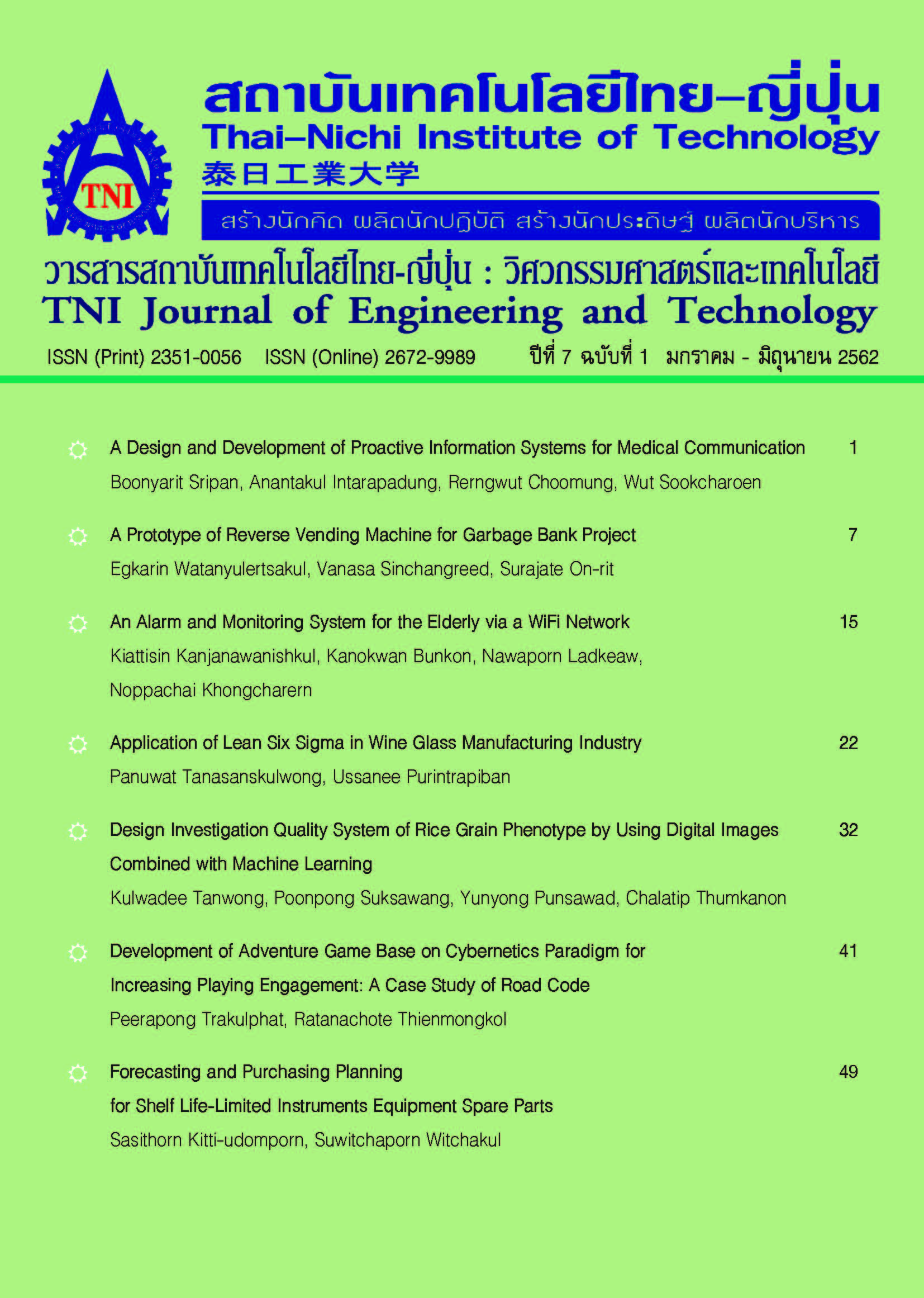Forecasting and Purchasing Planning for Shelf Life-Limited Instruments Equipment Spare Parts
Main Article Content
Abstract
Forecasting and Purchasing Planning for Shelf Life-Limited Instruments Equipment Spare Parts with a case study of company, purchasing spare parts from factories by selecting a forecasting method and applying a mathematical model. The purposes of this research are to improve the inventory quantity to be suitable for customers’ demand, to reduce holding cost and to minimize the total inventory cost. In the past, the company operations didn’t have purchasing planning strategy in the case study, the purchasing would be ordered when the inventory level is 0 that result shortage spare parts sometimes and the company had the policy about the spare parts with a limited 5-years lifetime. There were 17 items or 80% of total expired spare parts value that would be taken for forecasting and purchasing planning in this case study. We propose a new strategy about applying a mathematical model for purchasing planning spare parts that minimize the total inventory cost by using a new safety stock (SS) and customers’ demand that is the most accurate forecasting method with the lowest Mean Absolute Deviation (MAD) from 5 forecasting methods: 1) Moving Average, 2) Single Exponential Smoothing, 3) Double Exponential Smoothing, 4) Holt-Winters Smoothing, 5) Monte Carlo Simulation. From experiments, 17 items of the spare parts were the most suitable with Moving Average, Single Exponential Smoothing and Double Exponential Smoothing Method. In addition, this study calculated the new safety stock level at 95% confident level for new purchasing planning next year. Finally, The results of this study were found that the mathematical model for purchasing planning spare parts, could prevent the inventory shortage, reduce holding cost and minimize the total inventory cost from the current purchases of all items by 8,384,223 baht or decrease the average cost of 493,189.59 baht/year that is 17.55%
Article Details
Article Accepting Policy
The editorial board of Thai-Nichi Institute of Technology is pleased to receive articles from lecturers and experts in the fields of business administration, languages, engineering and technology written in Thai or English. The academic work submitted for publication must not be published in any other publication before and must not be under consideration of other journal submissions. Therefore, those interested in participating in the dissemination of work and knowledge can submit their article to the editorial board for further submission to the screening committee to consider publishing in the journal. The articles that can be published include solely research articles. Interested persons can prepare their articles by reviewing recommendations for article authors.
Copyright infringement is solely the responsibility of the author(s) of the article. Articles that have been published must be screened and reviewed for quality from qualified experts approved by the editorial board.
The text that appears within each article published in this research journal is a personal opinion of each author, nothing related to Thai-Nichi Institute of Technology, and other faculty members in the institution in any way. Responsibilities and accuracy for the content of each article are owned by each author. If there is any mistake, each author will be responsible for his/her own article(s).
The editorial board reserves the right not to bring any content, views or comments of articles in the Journal of Thai-Nichi Institute of Technology to publish before receiving permission from the authorized author(s) in writing. The published work is the copyright of the Journal of Thai-Nichi Institute of Technology.
References
P. Lalitaphorn, “Inventory Management in Supply Chains,” Bangkok: Technology Promotion Association (Thailand-Japan), 2016.
W. Chaimee, “Supply Chain Management and Operations,” Bangkok: TPIM, 2009.
S. Rungmaneerat, W. Panyangam, and P. Wangphanitcharoen, “The Application of the Advanced Purchasing Planning for Raw Material with the Dynamic Model,” Industrial Engineering Network Conference, Phetchaburi, Oct. 17-19, 2012.
W. Phupha, “The Application of Monte Carlo Simulation Model to Determine Suitable Order Quantity: A Case Study of Raw Material Purchasing in Food Processing Factory,” vol. 88, 2014, pp. 41-56.
K. Phabu, W. Panyangam, and N. Choomrit, “The Determination of Suitable Order Quantity with Dynamic Model: A Case Study of Rice Inventory at the Sample Rice Mill,” Industrial Engineering Network Conference, Phetchaburi, Oct. 2012, pp. 1899-1904.
H.M. Wagner, and T.M. Whitin, “Dynamic Version of the Economic Lot Size Models,” Management science, 1958, pp. 89-96.
J.R. Evans, “An Efficient Implementation of the Wagner-Whitin Algorithm for Dynamic Lot-Sizing,” Journal of Operations Management, Vol. 5, 1985, pp. 229-235.
J.J. Gonzalez, and R. Tullous, “The Lot Size Ordering Problem Using the Wagner-Whitin Model: A Spreadsheet Version,” Proceedings of the POMS, 2002.
Z. Hu, and G. Hu, “A two-stage stochastic programming model for lot-sizing and scheduling under uncertainty,” Int. J. Production Economics, vol. 180, 2016, pp.198-207.
G. Relph, and M. Newton, “Both Pareto and EOQ have limitation combining them delivers a powerful management tool for MRP and Beyond,” Int. J. Production Economics, vol. 157, 2014, pp. 24-30.

